Since 2018, YouthInsight has worked with the Department of Industry, Science and Resources (DISR) on research focusing on Australian students’ attitudes and behaviours toward science, technology, engineering and mathematics (STEM) education, and careers in STEM-related fields.
In 2020, DISR released the first edition of the STEM Equity Monitor on International Women’s Day, and has now published three iterations of the Monitor – which will be updated annually until 2029. The STEM Equity Monitor is a national data resource on girls and women in STEM, reporting on the current state of STEM gender equity in Australia, with YouthInsight carrying out research focusing on Youth, Parents, and Educators.
The third iteration of the STEM Equity Monitor is now available online, including the release of the 2022-23 STEM influencer report. With earlier research results indicating that parents and teachers are the greatest influencers of young people’s education and career decisions, this is Australia’s second STEM influencer study, which surveyed 730 teachers and career advisers, and 1,500 parents.
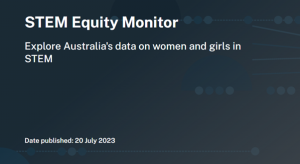
KEY INSIGHTS
- Globally, Industry 4.0 could perpetuate the gender imbalance in STEM, with women remaining a minority in areas including technology, computing, physics, mathematics and engineering.
- In Australia, though girls make up the majority of students in some year 12 STEM subjects, women hold only 15 per cent of STEM-qualified jobs.
- Despite some Australian parents showing gendered views when it comes to STEM engagement, careers and success, more than half of all parents do not believe that gender plays any part in a successful STEM career.
- Most educators in Australia believe boys and girls are equally confident in subject areas including mathematics, science and technology, but not engineering.
In 2021, the UNESCO Science Report warned of the risk that the Fourth Industrial Revolution (Industry 4.0) could continue the gender imbalance in STEM, with women remaining a minority in areas including technology, computing, physics, mathematics and engineering.
Previous research examining how students’ decisions on STEM are affected by external cues, found that “numerous government and other policy initiatives designed to get women interested in STEM fields may have the unintended effect of signalling to women an inherent lack of fit”. However, as we entered 2021, we saw a positive shift in education. Here, UNESCO reported that gender parity had been achieved globally at the bachelor’s and master’s levels (45–55%), while we remain on the verge of parity at the PhD level of study and research (44%). Despite this, the gender gap widens at the career stage, suggesting that the global phenomenon of the “leaky pipeline” of lost talent continues.
Globally, women in academia and industry continue to be underrepresented in STEM leadership and technical roles, experiencing both shorter and less well-paid careers. Following its analysis of almost 3 million computer science research articles published over a 48-year-period in the US (1970 to 2018), UNESCO concluded that within academic research gender parity would only be achieved in 2100.
Insights from the STEM Influencer Report
In Australia, the STEM Equity Monitor shows some improvements for girls and women in STEM. This includes a 68 per cent increase of women in STEM-qualified occupations (2012 to 2022), and a 31 per cent increase of women enrolling in university STEM courses (2015 to 2021).
Today, girls are the majority of students in some year 12 STEM subjects, including biological sciences, earth sciences, chemical sciences, and agricultural and environmental studies. However, there remains much work to be done before girls and women in Australia have equal opportunities in STEM overall.
Currently, girls’ confidence in STEM subjects is lower than boys, and falls as they get older. When it comes to tertiary education, they also make up only 37 per cent of enrolments in university STEM courses, and 17 per cent in VET.
In 2022, we observed an increase in the gap between women’s and men’s pay in STEM industries, which is 17 per cent. With women holding a total of only 15 per cent of STEM-qualified jobs, they also make up just 23 per cent of senior management roles and eight per cent of CEOs in these industries.
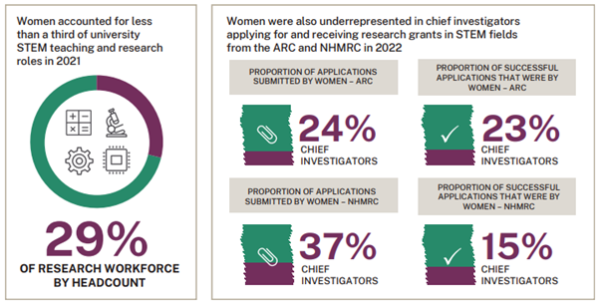
Source: Australian Government, STEM Equity Monitor Data report 2023 - Australian Research Council (2022); Department of Education (2021); National Health and Medical Research Council (2023)
Parental Perceptions on STEM and Gender
With most parents (90%) agreeing that a STEM-skilled workforce is important for the Australian economy, YouthInsight asked parents about the ease of engaging girls and boys in STEM. Here, we found that 58 per cent agreed that it is easier to engage boys in STEM compared to other subject areas, while only 37 per cent thought the same when it came to girls.
Overall, almost one in two parents (49%) agreed that it is easier to engage boys than girls with STEM. Here, however, parents from Culturally and Linguistically Diverse backgrounds showed a variance in views from the total population, and reported that it was easier to engage girls with STEM subjects compared to other subject areas (which is significantly higher than parents from non-Culturally and Linguistically Diverse backgrounds).
When it comes to career success in STEM, a higher proportion of both fathers and mothers agreed that boys had a better chance of success in STEM-related careers, with parents of boys more likely to agree that boys are better suited to STEM careers than girls (38%) compared to parents of girls (28%).
Despite these findings, more than half of all parents surveyed did not believe that gender plays any part in a successful STEM career. Here, we found that 58 per cent of parents disagreed that boys have a better chance at STEM success compared to girls, while 66 per cent disagreed that boys are better suited to a STEM career than girls.
Access the full Parents’ perceptions and attitudes to STEM survey results here.
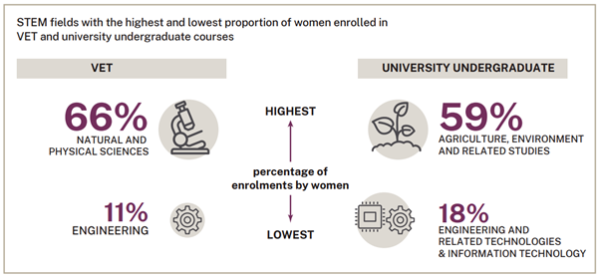
Source: Australian Government, STEM Equity Monitor Data report 2023 - Department of Education (2023); National Centre for Vocational Education Research (2022)
Teachers and Career Advisers’ views on STEM and Gender
In 2023, almost all educators (98%) believe that STEM skills are important for the Australian economy, and 89 per cent agree that such skills provide job security for future workers.
When it comes to confidence in STEM, most educators reported that boys and girls are equally confident in subject areas including mathematics, science and technology, however not in engineering. Here, three in five educators (63%) believed that boys were more confident than girls. Overall, where gender differences in confidence were reported, these were heavily skewed toward boys.
Our research found strong gender associations from educators when it came to different jobs. Here, educators primarily associated jobs including nurse, office support, and teacher with women, while labourer, trade worker, and machinery operator were most associated with men.
The data additionally showed correlation between gender associations of different jobs and their perceived importance of STEM skills. This included computing or information technology jobs – which were associated with men – where STEM skills were perceived as most essential, while pharmacist was the only job associated with women where STEM skills were perceived as essential. These results were consistent across both the STEM influencer parent and educator surveys.
Access the full Teachers and Career Advisers’ perceptions and attitudes to STEM survey results here.
KEY TAKEAWAYS
As the STEM Equity Monitor shows some improvements for girls and women, there remains much work to be done before girls and women in Australia have equal opportunities in STEM overall. These outcomes are similar to global research and reporting from organisations including UNESCO, which has warned of the risk that the Fourth Industrial Revolution could continue the gender imbalance in STEM, with women remaining a minority in these areas.
To address these issues, this year the Australian Government launched the Diversity in STEM review. The review aims to find ways to improve diversity in science, technology, engineering and mathematics. With the project beginning in early 2023, the independent panel leading the review will recommend how the Australian Government can support change so that people can access and feel they belong within STEM education, careers and industries in late 2023.
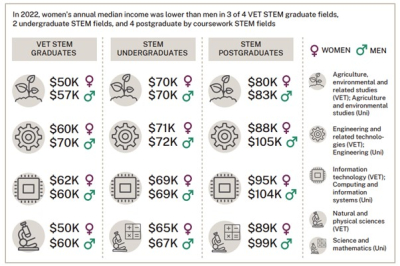
Source: Australian Government, STEM Equity Monitor Data report 2023 - National Centre for Vocational Education Research (2022); Social Research Centre (2022)
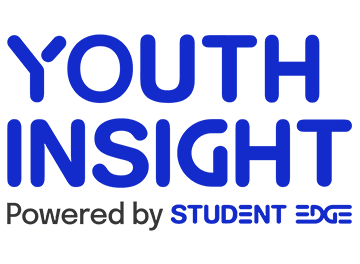





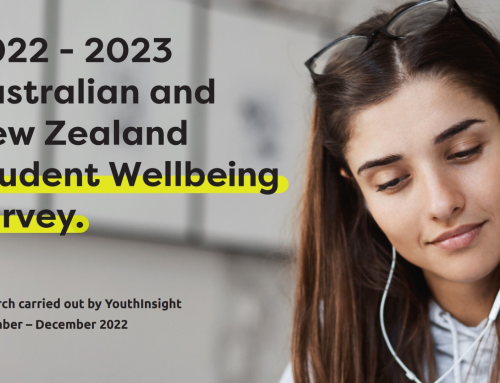


Leave A Comment